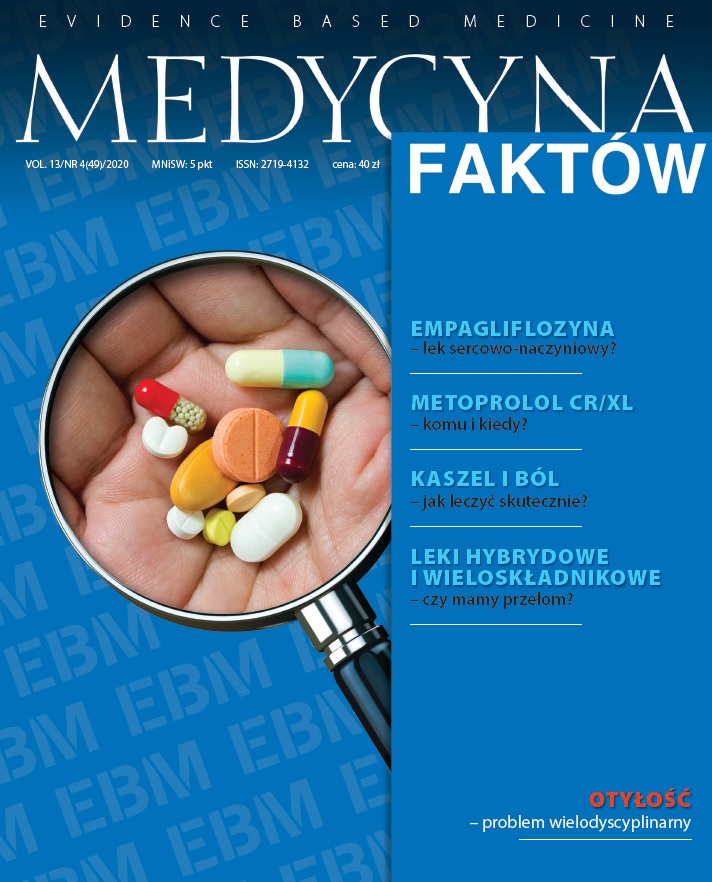5 faktów na temat stosowania loperamidu Artykuł przeglądowy
##plugins.themes.bootstrap3.article.main##
Abstrakt
Biegunka jest bardzo częstym problemem mogącym stanowić nie tylko niecharakterystyczny objaw chorobowy, lecz także może być powikłaniem infekcyjnym albo zwiastować chorobę przewlekłą. Od lat swoje miejsce w leczeniu biegunek ostrych i przewlekłych znajduje loperamid. Profil bezpieczeństwa i skuteczność działania tego leku pozwalają na samodzielne stosowanie go przez pacjenta przez pierwszy okres chorobowy do ustąpienia objawów. Loperamid przynosi korzystne efekty u pacjentów z parciem naglącym i po zabiegu na jelicie krętym, zagęszczając i formując stolec oraz wpływając na napięcie mięśni odbytu. Ponadto sprawdza się w biegunkach podróżnych, samodzielnie lub w terapii łączonej z dedykowanym lekiem. Nie wywołuje długotrwałych objawów ubocznych, działa szybko, opanowując objawy chorobowe i zapobiegając powikłaniom pogarszającym przebieg choroby, np. odwodnieniu. Mimo innych alternatyw na rynku wciąż znajduje się w czołówce skutecznych i bezpiecznych leków przeciwbiegunkowych.
##plugins.themes.bootstrap3.article.details##
Copyright © by Medical Education. All rights reserved.
Bibliografia
2. Kalgutkar AS, Nguyen HT. Identification of an N-methyl-4-phenylpyridinium-like metabolite of the antidiarrheal agent loperamide in human liver microsomes: underlying reason(s) for the lack of neurotoxicity despite the bioactivation event. Drug Metab Dispos. 2004; 32(9): 943-52.
3. Yu JH, Kim HJ, Lee S et al. LC-MS determination and bioavailability study of loperamide hydrochlorideafter oral administration of loperamide capsule in human volunteers. J Pharm Biomed Anal. 2004; 36(2): 421-7.
4. Kim KA, Chung J, Jung DH et al. Identification of cytochrome P450 isoforms involved in the metabolism of loperamide in human liver microsomes. Eur J Clin Pharmacol. 2004; 60(8): 575-81.
5. Eggleston W, Nacca, Marraffa JM. Loperamide toxicokinetics: serum concentrations in the overdose setting. Clin Toxicol (Phila). 2015; 53(5): 495-6.
6. Florez JD, Veroniki AA, Khalifah A et al. Comparative effectiveness and safety of interventions for acute diarrhea and gastroenteritis in children: A systematic review and network meta-analysis. PLoS One. 2018; 12(13): e0207701.
7. Liu L, Oza S, Hogan D et al. Global, regional and national causes of child mortality in 2000–13, with projections to inform post-2015 priorities: an updated systematic analysis. The Lancet. 2015; 385(9966): 430-40.
8. Florez ID, Al-Khalifah R, Sierra JM et al. The effectiveness and safety of treatments used for acute diarrhea and acute gastroenteritis in children: protocol for a systematic review and network meta-analysis. Systematic Reviews. 2016; 5(1): 1-9.
9. Alejandro B, Guillermo T, Ángeles PM. Formulation and Evaluation of Loperamide HCl Oro Dispersible Tablets. Pharmaceuticals. 2020; 13(5): 100.
10. Agiba AM, Eldin AB. Insights into formulation technologies and novel strategies for the design of orally disintegrating dosage forms: A comprehensive industrial revive. Int J Pharmacy Pharmaceutical Sci. 2019; 11(9): 118-20.
11. Fischbach W, Andresen V, Eberlin M et al. A Comprehensive comparison of the efficacy and tolerability of racecadotril with other treatment of acute diarrhea in adults. Front Med (Lausanne). 2016; 14(3): 44.
12. Taylor DN, Hamer DH, Shlim DR. Medications for the prevention and treatment of travellers’ diarrhea. J Travel Med. 2017; 24(suppl 1): S17-S22.
13. DuPont AW, Sellin JH. Ileostomy diarrhea. Curr Treat Options Gastroenterol. 2006; 9(1): 39-48.
14. Leung AKC, Leung AAM, Wong AHC et al. Travelers’ Diarrhea: A Clinical Review. Recent Pat Inflamm Allergy Drug Discov. 2019; 13(1): 38-48.
15. Riddle MS, Connor P, Fraser J et al.; TrEAT TD Study Team. Trial Evaluating Ambulatory Therapy of Travelers’ Diarrhea (TrEAT TD) Study: A Randomized Controlled Trial Comparing 3 Single-Dose Antibiotic Regimens With Loperamide. Clin Infect Dis. 2017; 65(12): 2008-17.
16. Hitch G. A Review of Guidelines/Guidance from Various Countries Around the World for the Prevention and Management of Travelers’ Diarrhea: A Pharmacist’s Perspective. Pharmacy (Basel). 2019; 7(3): 107.
17. FDA Drug Safety Communication: FDA updates warnings for oral and injectable fluoroquinolone antibiotics due to disabling side effects. Safety announcement. 2016.
18. Connor BA. The prevalent consultation: Travelers’diarrhea. In: CDC Yellow Book. Health Information for International Travel. Oxford University Press, New York 2020.
19. Baker DE. Loperamide: A pharmacological review. Rev Gastroenterol Disord. 2007; 7(suppl 3): 11-8.
20. Vandenbossche J, Huisman M, Xu Y et al. Loperamide and P-glycoprotein inhibition: assessment of the clinical relevance. J Pharm Pharmacol. 2010; 62(4): 401-12.
21. Wu PE, Juurlink DN. Clinical Review: Loperamide Toxicity. Ann Emerg Med. 2017; 70(2): 245-52.
22. Eggleston W, Palmer R, Dubé PA et al. Loperamide toxicity: recommendations for patient monitoring and management. Clin Toxicol (Phila). 2020; 58(5): 355-9.
